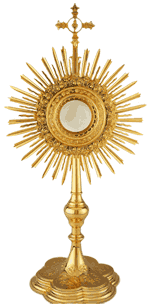During the years I lived in Rome, I spent a lot of time trying to decipher and understand early Christian symbolism. It was a hobby of mine as I visited churches and saw so much iconography. Recently, someone visited St. Stephen Church in New Orleans and asked me about an image that they saw high over the sanctuary of a pelican feeding its young. They wondered why someone would have painted the “state bird” in church! The question gave me a good occasion to reflect upon church symbolism.
The image of the mother pelican feeding her baby pelicans is rooted in several ancient Roman legends that precede Christianity. One version is that in time of famine, the mother pelican wounded herself, striking her breast with her beak to feed her young with her blood. Another version was that the mother fed her dying young with her blood to revive them from death, but in turn lost her own life.
Given these traditions, one can easily understand how early Christians adapted it to symbolize our Lord, Jesus Christ. The pelican symbolizes Jesus our Redeemer who gave His life for our redemption and feeds us with His Body and Blood in the Eucharist. We were dead to sin and have found new life through the sacrifice of Christ.
This tradition and others is found in the Physiologus, an early Christian work which appeared in the second century in Alexandria, Egypt. Written by an anonymous author, the Physiologus recorded legends of animals and gave each an allegorical interpretation. The legend is described: “The little pelicans strike their parents, and the parents, striking back, kill them. But on the third day the mother pelican strikes and opens her side and pours blood over her dead young. In this way they are revivified and made well. So Our Lord Jesus Christ says also through the prophet Isaiah: I have brought up children and exalted them, but they have despised me (Is 1:2). We struck God by serving the creature rather than the Creator. Therefore, He deigned to ascend the cross, and when His side was pierced, blood and water gushed forth unto our salvation and eternal life.” This work was noted by noted by numerous authors and was popular in the Middle Ages as a source for the symbols used in the various stone carvings and other artwork of that period.
In 1312 Dante wrote in his “Paridiso” of Christ as “our Pelican who shed His blood in order to give eternal life to the children of men.” In 1606 John Lyly wrote in his
“Euphues” of the “pelicane who stricketh blood out of its owne bodye to do others good.” In Hamlet, William Shakespeare wrote “to his good friend thus wide, I’ll ope my arms and, like the kind, life-rendering pelican repast them with my blood.”
The pelican also has been part of our liturgical tradition. In his great Eucharistic hymn “Adoro te devote,” St. Thomas Aquinas asks the pie pelicane, Jesu Domine, (the pious pelican, Lord Jesus) to “wash my filthiness and clean me with your blood.”
Those of us in Louisiana are very familiar with pelicans. Anybody who fishes in Lake Pontchartrain or along the coast are used to seeing pelicans flying across the water and perching themselves on pilings. The pelican is our state bird, and the motto of Louisiana is the “Pelican State.” Even the State Flag of Louisiana uses the image of a pelican. But interestingly enough, the image on the flag is not that of a pelican in flight or perched on a piling; it’s the familiar image taken from the Roman legend: that of a pelican feeding its young.
It shouldn’t be surprising that the pelican symbolism was employed on the front of the altar used for the final Mass when Louisiana hosted the 8th National Eucharistic Congress in October of 1939, in a crystal clear Eucharistic reference.
So an ancient secular legend was appropriated to symbolize a Christian mystery, and that symbol became a secular image familiar to anyone in Louisiana seeing the state flag. As for me, understanding the symbolism of the pelican and seeing them in nature provides a ready reminder of Christ’s redemptive love and His Real Presence in the Holy Eucharist., something to reflect on during this Year of the Eucharist in the Archdiocese of New Orleans.




